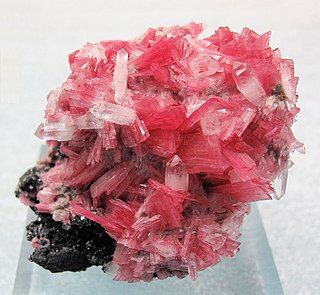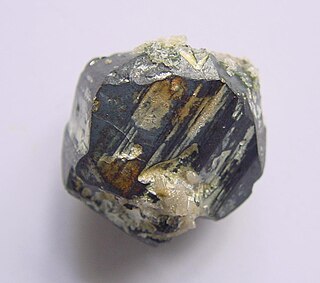
Prehnite is an inosilicate of calcium and aluminium with the formula: Ca2Al(AlSi3O10)(OH)2 with limited Fe3+ substitutes for aluminium in the structure. Prehnite crystallizes in the orthorhombic crystal system, and most often forms as stalactitic, botryoidal, reniform or globular aggregates, with only just the crests of small crystals showing any faces, which are almost always curved or composite. Very rarely will it form distinct, well-individualized crystals showing a square-like cross-section, including those found at the Jeffrey Mine in Asbestos, Quebec, Canada. Prehnite is brittle with an uneven fracture and a vitreous to pearly luster. Its hardness is 6.5, its specific gravity is 2.80–2.95 and its color varies from light green to yellow, but also colorless, blue, pink or white. In April 2000, rare orange prehnite was discovered in the Kalahari Manganese Fields, South Africa. Prehnite is mostly translucent, and rarely transparent.

Bornite, also known as peacock ore, is a sulfide mineral with chemical composition Cu5FeS4 that crystallizes in the orthorhombic system (pseudo-cubic).

Galena, also called lead glance, is the natural mineral form of lead(II) sulfide (PbS). It is the most important ore of lead and an important source of silver.

Acanthite is a form of silver sulfide with the chemical formula Ag2S. It crystallizes in the monoclinic system and is the stable form of silver sulfide below 173 °C (343 °F). Argentite is the stable form above that temperature. As argentite cools below that temperature its cubic form is distorted to the monoclinic form of acanthite. Below 173 °C acanthite forms directly. Acanthite is the only stable form in normal air temperature.

Manganite is a mineral composed of manganese oxide-hydroxide, MnO(OH), crystallizing in the monoclinic system (pseudo-orthorhombic). Crystals of manganite are prismatic and deeply striated parallel to their length; they are often grouped together in bundles. The color is dark steel-grey to iron-black, and the luster brilliant and submetallic. The streak is dark reddish brown. The hardness is 4, and the specific gravity is 4.3. There is a perfect cleavage parallel to the brachypinacoid, and less-perfect cleavage parallel to the prism faces. Twinned crystals are not infrequent.

Rhodonite is a manganese inosilicate, with the formula (Mn, Fe, Mg, Ca)SiO3, and member of the pyroxenoid group of minerals, crystallizing in the triclinic system. It commonly occurs as cleavable to compact masses with a rose-red color (its name comes from Ancient Greek ῥόδον (rhódon) 'rose'), often tending to brown due to surface oxidation. The rose-red hue is caused by the manganese cation (Mn2+).

Oldhamite is a calcium magnesium sulfide mineral with the chemical formula (Ca,Mg)S. Ferrous iron may also be present in the mineral resulting in the chemical formula (Ca,Mg,Fe)S. It is a pale to dark brown accessory mineral in meteorites. It crystallizes in the cubic crystal system, but typically occurs as anhedral grains between other minerals.

Lithiophilite is a mineral containing the element lithium. It is lithium manganese(II) phosphate with chemical formula LiMnPO4. It occurs in pegmatites often associated with triphylite, the iron end member in a solid solution series. The mineral with intermediate composition is known as sicklerite and has the chemical formula Li(Mn,Fe)PO4). The name lithiophilite is derived from the Greek philos (φιλός) "friend", as lithiophilite is usually found with lithium.

Sperrylite is a platinum arsenide mineral with the chemical formula PtAs2 and is an opaque metallic tin white mineral which crystallizes in the isometric system with the pyrite group structure. It forms cubic, octahedral or pyritohedral crystals in addition to massive and reniform habits. It has a Mohs hardness of 6–7 and a very high specific gravity of 10.6.

Babingtonite is a calcium iron manganese inosilicate mineral with the formula Ca2(Fe,Mn)FeSi5O14(OH). It is unusual in that iron(III) completely replaces the aluminium so typical of silicate minerals. It is a very dark green to black translucent mineral crystallizing in the triclinic system with typically radial short prismatic clusters and druzy coatings. It occurs with zeolite minerals in cavities in volcanic rocks. Babingtonite contains both iron(II) and iron(III) and shows weak magnetism. It has a Mohs hardness of 5.5 to 6 and a specific gravity of 3.3.

Digenite is a copper sulfide mineral with formula: Cu9S5. Digenite is a black to dark blue opaque mineral that crystallizes with a trigonal–hexagonal scalenohedral structure. In habit it is usually massive, but does often show pseudo-cubic forms. It has poor to indistinct cleavage and a brittle fracture. It has a Mohs hardness of 2.5 to 3 and a specific gravity of 5.6. It is found in copper sulfide deposits of both primary and supergene occurrences. It is typically associated with and often intergrown with chalcocite, covellite, djurleite, bornite, chalcopyrite and pyrite. The type locality is Sangerhausen, Thuringia, Germany, in copper slate deposits.

Djurleite is a copper sulfide mineral of secondary origin with formula Cu31S16 that crystallizes with monoclinic-prismatic symmetry. It is typically massive in form, but does at times develop thin tabular to prismatic crystals. It occurs with other supergene minerals such as chalcocite, covellite and digenite in the enriched zone of copper orebodies. It is a member of the chalcocite group, and very similar to chalcocite, Cu2S, in its composition and properties, but the two minerals can be distinguished from each other by x-ray powder diffraction. Intergrowths and transformations between djurleite, digenite and chalcocite are common. Many of the reported associations of digenite and djurleite, however, identified by powder diffraction, could be anilite and djurleite, as anilite transforms to digenite during grinding.

Chlorargyrite is the mineral form of silver chloride (AgCl). Chlorargyrite occurs as a secondary mineral phase in the oxidation of silver mineral deposits. It crystallizes in the isometric–hexoctahedral crystal class. Typically massive to columnar in occurrence it also has been found as colorless to variably yellow cubic crystals. The color changes to brown or purple on exposure to light. It is quite soft with a Mohs hardness of 1 to 2 and dense with a specific gravity of 5.55. It is also known as cerargyrite and, when weathered by desert air, as horn silver. Bromian chlorargyrite is also common. Chlorargyrite is water-insoluble.

Corderoite is an extremely rare mercury sulfide chloride mineral with formula Hg3S2Cl2. It crystallizes in the isometric crystal system. It is soft, 1.5 to 2 on the Mohs scale, and varies in color from light gray to black and rarely pink or yellow.

Manganese(II) sulfide is a chemical compound of manganese and sulfur. It occurs in nature as the mineral alabandite (isometric), rambergite (hexagonal), and recently found browneite.
Fletcherite is a rare thiospinel sulfide mineral with formula Cu(Ni,Co)2S4. It is an opaque metallic steel gray mineral which crystallizes in the cubic crystal system. It is a member of the linnaeite group.

Mendipite is a rare mineral that was named in 1939 for the locality where it is found, the Mendip Hills in Somerset, England. It is an oxyhalide of lead with formula Pb3Cl2O2.
Mooihoekite is a copper iron sulfide mineral with chemical formula of Cu9Fe9S16. The mineral was discovered in 1972 and received its name from its discovery area, the Mooihoek mine in Transvaal, South Africa.

Semseyite is a rarely occurring sulfosalt mineral and is part of the class of lead antimony sulfides. It crystallizes in the monoclinic system with the chemical composition Pb9Sb8S21. The mineral forms dark gray to black aggregates.

Daubréelite is a rare sulfide mineral. It crystallizes with cubic symmetry and has chemical composition of Fe2+Cr3+2S4. It usually occurs as black platy aggregates.


















